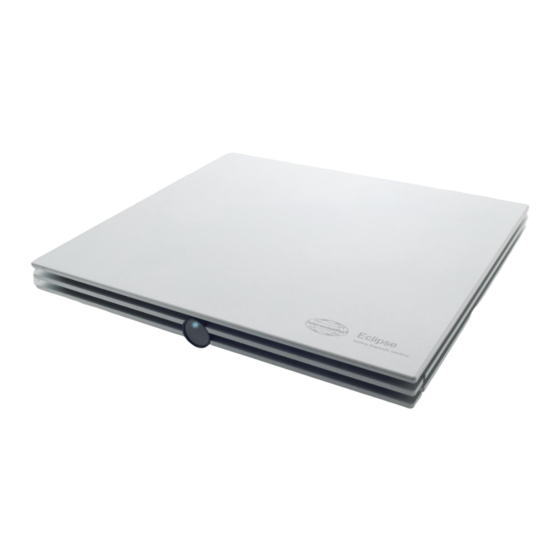
User Manuals: Interacoustics Eclipse Equipment
Manuals and User Guides for Interacoustics Eclipse Equipment. We have 4 Interacoustics Eclipse Equipment manuals available for free PDF download: Additional Information, Instructions For Use Manual, Quick Manual
Interacoustics Eclipse Additional Information (235 pages)
Brand: Interacoustics
|
Category: Medical Equipment
|
Size: 5 MB
Table of Contents
-
-
3 Ep15/
25-
Edit Tab39
-
Latency Tab44
-
System Setup46
-
-
Print Wizard47
-
Rejection57
-
-
Printing69
-
ABR Masking77
-
Loop Back92
-
-
5 Vemp
113-
-
Edit Tab116
-
-
System Setup121
-
Cvemp Results129
-
Ovemp Results135
-
6 Assr
137-
-
Analysis137
-
SNR in ASSR139
-
-
-
Toolbar141
-
The ASSR Tab143
-
Eeg144
-
Frequency Curves144
-
The Table146
-
-
System Setup149
-
Auto Tests Setup149
-
General Setup151
-
Report Templates152
-
-
ASSR Results159
-
Bc Assr161
-
ASSR Masking163
-
7 Abris
167-
System Setup170
-
General Setup170
-
Report Setup171
-
Password172
-
-
ABRIS Results175
-
8 Dpoae
177-
-
Auto Test Setup183
-
Template184
-
Norm Data185
-
-
Results188
-
9 Teoae
193-
-
Auto Test197
-
General Setup199
-
Printer Layout200
-
Report Templates201
-
Auto Screening202
-
-
-
Probe Check204
-
Rejection Level204
-
Start the Test204
-
TEOAE Results205
-
-
-
General FAQ209
-
Faq - Abr214
-
ABR Preparation214
-
ABR Recordings214
-
ABR Latency Data218
-
ABR System220
-
-
Faq - Vemp221
-
Faq - Assr222
-
Faq - Dpoae225
-
-
11 Dictionary
227
Advertisement
Interacoustics Eclipse Instructions For Use Manual (147 pages)
Brand: Interacoustics
|
Category: Test Equipment
|
Size: 3 MB
Table of Contents
-
-
-
-
Reporting29
-
Printing30
-
Talk Forward30
-
Save & New32
-
Save & Exit32
-
Start / Stop33
-
Pause34
-
Raw EEG35
-
Advanced EEG35
-
Display Gain37
-
PC Shortcuts50
-
-
Transducers51
-
-
-
VEMP Monitor70
-
VEMP Scaling71
-
-
-
Impedance Check112
-
The ASSR Tab113
-
Main Menu Items113
-
Temporary Setup114
-
Reporting114
-
Printing114
-
Save & Exit114
-
Stimulus Window114
-
Stimulus Rate115
-
-
-
Start & Stop116
-
Pause116
-
Raw EEG Graphs116
-
ASSR Table117
-
-
9 Maintenance
127 -
Interacoustics Eclipse Instructions For Use Manual (113 pages)
ABR screening system
Brand: Interacoustics
|
Category: Medical Equipment
|
Size: 2 MB
Table of Contents
-
-
Intended Use10
-
Warnings12
-
-
-
-
Reporting29
-
Printing30
-
Talk Forward30
-
Save & New31
-
Save & Exit31
-
Start / Stop33
-
Pause33
-
Raw EEG34
-
Advanced EEG34
-
Display Gain35
-
The Edit Tab35
-
PC Shortcuts46
-
-
Transducers47
-
-
-
-
Reporting69
-
Printing69
-
Save & Exit70
-
Status70
-
-
-
Reporting79
-
Printing79
-
Save & Exit79
-
Save & New80
-
-
Probe Check82
-
Level Graph82
-
DPOAE Graph83
-
Graph84
-
-
-
The ASSR Tab88
-
Reporting89
-
Printing89
-
Save & Exit89
-
PC Shortcuts96
-
-
-
TEOAE25 Module111
-
DPOAE20 Module112
-
ASSR Module112
Advertisement
Interacoustics Eclipse Quick Manual (5 pages)
Some hints to improve ABR / ABRIS / ASSR recordings
Brand: Interacoustics
|
Category: Test Equipment
|
Size: 0 MB



